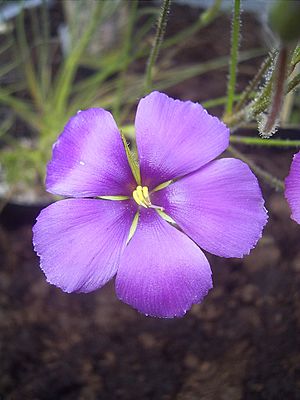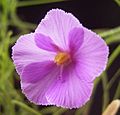Rainbow plant facts for kids
Quick facts for kids Rainbow plant |
|
|---|---|
 |
|
| Conservation status | |
| Scientific classification | |
| Genus: |
Byblis (plant)
|
| Species: |
gigantea
|
| Synonyms | |
|
|
The Rainbow Plant (Byblis gigantea) is a special type of plant that eats insects! It's known as a carnivorous plant. You can only find this amazing plant in Australia. It's part of a plant family called Byblidaceae.
Contents
What is the Rainbow Plant Like?
This plant is a small perennial herb or sub-shrub. This means it lives for more than two years and has a soft stem, or a slightly woody stem like a small bush. It has many branches and usually grows to be about 0.45 metres (1.5 ft) tall. It's a leafy plant with its leaves growing close together.
Roots and Flowers
The Rainbow Plant has deep, woody roots that can help it grow back after a fire. These roots are called rhizomes. The plant blooms between September and January. Its flowers are a pretty mix of pink-purple and white.
Seeds and Capsules
After flowering, it forms a round seed capsule with many faint lines. The seeds inside are tiny, about 0.6 to 1.5 millimetres (0.024 to 0.059 in) long and 0.6 to 1.0 mm (0.024 to 0.039 in) wide. They have cool, bumpy patterns like little ridges.
How Was the Rainbow Plant Named?
The Rainbow Plant was first officially described by a botanist named John Lindley in 1839. He wrote about it in his book, A Sketch of the Vegetation of the Swan River Colony. The only other name it was known by for a while was Byblis lindleyana, given by Jules Émile Planchon in 1848.
Where the Name Comes From
The first plant specimen was found by James Drummond in 1839 near the Swan River. The second part of its scientific name, gigantea, comes from the Latin word giganteus. This means giant, because this plant is bigger than another similar plant called Byblis liniflora.
Plant Family Relations
B. gigantea is closely related to another plant called Byblis lamellata. However, their seeds look different.
Where Does the Rainbow Plant Live?
The Rainbow Plant is found in different spots across Western Australia. You can see it from the Wheatbelt area near Dandaragan in the north. It also grows through the suburbs of Perth, Western Australia on the Swan Coastal Plain and into the Darling Range. It stretches south as far as Boddington in the Peel region.
Its Favorite Homes
This plant often lives in or near swamps and places that get wet during certain seasons. It likes sandy, peaty soils. It usually grows among low shrubs, especially those from the Leptospermum and Restionaceae plant families.
Is the Rainbow Plant in Danger?
Yes, the Rainbow Plant is in trouble. In 2000, the International Union for Conservation of Nature (IUCN) listed it as Critically Endangered. This means it's at a very high risk of disappearing forever.
Why It's Endangered
In 2002, it was also listed as a "Priority Two" plant in Australia. This is mainly because it has disappeared from many places where it used to grow. This is happening because cities, like Perth, are growing bigger, and buildings are taking over the plant's natural habitat.
How to Grow the Rainbow Plant
B. gigantea likes conditions that are a bit drier than what most sundew plants prefer. It grows well in large pots filled with very sandy soil. You should water it from the top only.
Tips for Growing
These plants can sometimes get sick from fungus, especially when they are young. To help the seeds sprout, you might need to treat them with a special chemical called gibberellic acid or use a fire treatment on the pot. The age of the seeds doesn't seem to matter much; even seeds over 22 years old have sprouted after being treated with fire!
Images for kids





